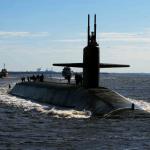US Navy’s Deployment of New “Low-Yield” Nuclear Warhead a Dangerous Step

The US has deployed its first low-yield Trident nuclear warhead on a submarine that is currently patrolling the Atlantic Ocean, it has been reported, in what arms control advocates warn is a dangerous step towards making a nuclear launch more likely.
According to the Federation of American Scientists, the USS Tennessee – which left port in Georgia at the end of last year – is the first submarine to go on patrol armed with the W76-2 warhead, commissioned by Donald Trump two years ago.
It has an explosive yield of five kilotons, a third of the power of the “Little Boy” bomb dropped on Hiroshima and considerably lower than the 90- and 455-kiloton warheads on other US submarine-launched ballistic missiles.
The Trump administration’s nuclear posture review (NPR) in February 2018, portrays this warhead as a counter to a perceived Russian threat to use its own “tactical” nuclear weapons to win a quick victory on the battlefield.
Advocates of W76-2 argued that the US had no effective deterrent against Russian tactical weapons because Moscow assumed Washington would not risk using the overwhelming power of its intercontinental ballistic missiles in response, for fear of escalating from a regional conflict to a civilian-destroying war.
Critics of the warhead say it accelerates a drift towards thinking of nuclear weapons as a means to fight and win wars, rather than as purely a deterrent of last resort. And the fielding of a tactical nuclear weapon, they warn, gives US political and military leaders a dangerous new option in confronting adversaries other than Russia.
Trump’s NPR says the US could use nuclear weapons in response to “significant non-nuclear strategic attacks”, including but not limited to “attacks on US, allied or partner civilian population or infrastructure”.
The US Navy and Strategic Command did not immediately respond to a request for comment. Hans Kristensen, the director of the nuclear information project at FAS, said the report on the arming of the USS Tennessee is based on briefings from officials.
“We have had conversations with people inside, and they’ve been pretty clear that this has happened,” Kristensen said. “They see a need to talk about it to some extent, because if people don’t know it’s out there, then how can it deter?”
“This is a very rapid mind quick turnaround for a nuclear weapon, and that’s obviously because it was a fairly simple adjustment of an existing warhead,” he added. “They have argued that this is to deter Russia, but it also has clear implications or potential use against other adversaries, not least North Korea and Iran.”
Kristensen said: “Certainly the low-yield collateral effect that would come from this weapon would be very beneficial to a military officer who was going to advise to the president whether we should cross the nuclear threshold.”
[Julian Borger is the Guardian's world affairs editor. He was previously a correspondent in the US, the Middle East, eastern Europe and the Balkans. His book on the pursuit and capture of the Balkan war criminals, The Butcher's Trail, is published by Other Press. Click here for Julian's public key.]
